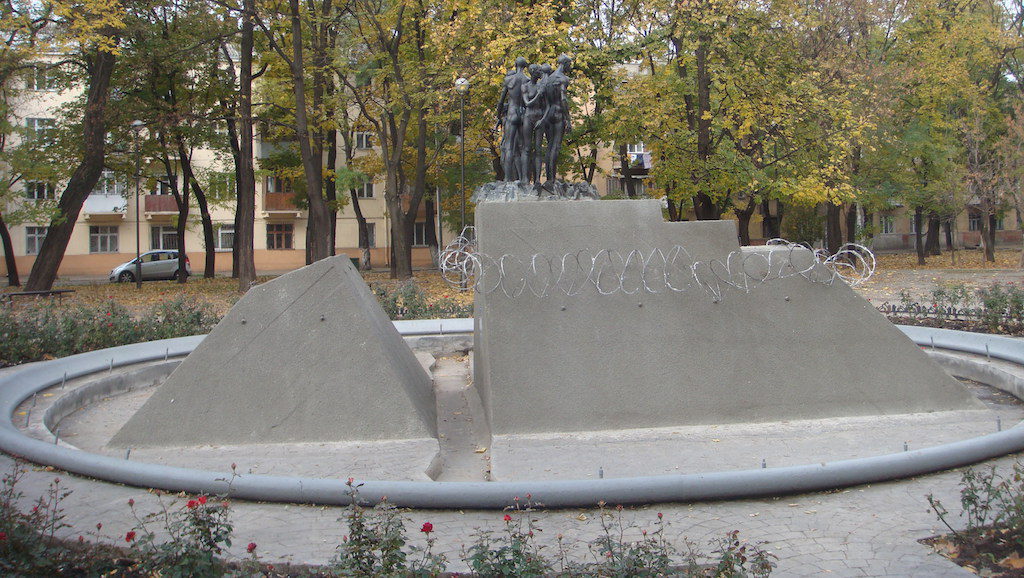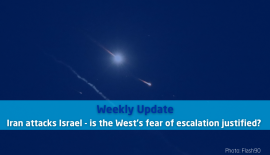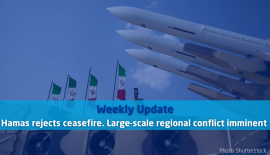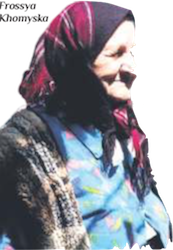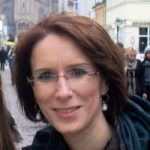Thank You For Not Forgetting Us!
A fresh breeze is blowing, carrying first the Ukrainian, then the Israeli national anthem, the Hatikva. The sound travels across a wheat field onto the horizon where horse stables used to be. They served as living quarters for the Jews from the village who were enslaved as forced labourers back then, when first the Germans, then the Romanians occupied this strip of land.
One hundred and sixty of these Jewish victims are lying in a mass grave here, where a memorial is being dedicated, 73 years later, on 19 June 2017. The memorial stone was donated by Christians for Israel. The gathering includes members of Bershad’s Jewish community, residents of the nearby village of Oseyevka, representatives of the local authorities and a Dutch-German group of volunteers who were participating in a working trip to Ukraine. Some of the victims in this grave were from the nearby former Jewish shtetl (a small town formed in Central and Eastern Europe before the Holocaust with a large Jewish community) of Bershad.
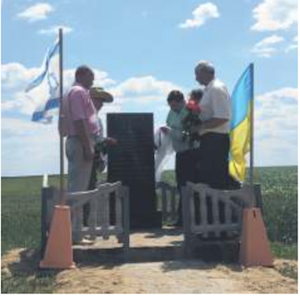
Dedication of a memorial for 160 Jews who were driven to forced labour in the fields of Oseyevka near Bershad during World War II and died.
Europe’s oldest, 200 year old clay synagogue is located in Bershad. It is here that Aleksander Shornitskyshares some of his story with the group – a story that stands for so many other fates. “I was born in 1934 in Ternovka, a small shtetl in Western Ukraine,” says Shornitsky. “The repressions began immediately after Nazi Germany’s attack on the Soviet Union 22 June 1941, followed by the systematic shooting to death of the Jewish population. That is, mainly women, children and old people as Jewish men of military age were drafted into the Red Army immediately after the outbreak of the war.” “In Spring of 1942, it was our shtetl’s turn,”Shornitsky continues. “But our mother had provided for us by digging a secret cellar under our house.”
>> Survival
That is how Shornitsky survived the first wave of shootings, together with two sisters. But then the Nazis began chasing the Jews who were not caught the first time. In the German-occupied part of Ukraine, where Shornitsky’s hometown was located, the chance for survival was close to zero. In the southwestern part of Ukraine, in the then-called region of Transnistria, located between the rivers Bug and Dniester, had been turned over to Hitler Germany’s Fascist ally Romania based on the Tighina Agreement of August 1941, the operations of the police forces were less systematic. The annihilation of neighbouring Romania’s Jews was achieved primarily indirectly when Romanian authorities drove approximately 100,000 Jews out of its territory across the Bug River into Transnistria in late Autumn of 1941 without any supplies. Most of the deportees died from hunger, cold and disease. Those who made it to one of the shtetls had to squeeze into the already crowded huts together with the resident Jewish population. Still, many Jews tried to escape the death trap of the German- occupied territories to Transnistria, including Shornitsky. “With the help of some kind Ukrainians who knew the area and the location of the guards, we – that is about one hundred Jews – were able to escape across the southern Bug River.” Eventually, Shornitsky made it to Bershad.
“The chances for survival were still low. A terrible typhus epidemic broke out in the ghetto in winter of 1941, caused by the inhumane hygienic conditions. I remember how the horse cart would come every day to pick up the corpses.”
Shornitzky survived, along with 3,000 of Bershad’s Jews, who managed in the following decades to stay under the radar of the Soviet regime that suppressed any religious activity, and to observe the high Jewishholidays.
“Neither me nor my surviving friends harbour any hatred against the Germans in our hearts. We do recognise their contributions to the world’s culture, and we appreciate Germany standing up against anti-Semitism today…” says Shornitsky to the Dutch-German group before they left for Oseyevka, along the dirt road, where the wheat is softly swaying in the wind and the Ukrainian babushkas, heads covered with kerchiefs, are standing under the roof of the village well, waiting for the ceremony to begin.
One hundred such mass graves are located around Bershad; 2,000 throughout Ukraine, containing the remains of 1.7 million Ukrainian Jews murdered in World War II. Some have memorial plaques; many don’t. It was not until after the collapse of the Soviet Union that historical data became accessible and was allowed to be made public, including the fate of the Jewish victims. Even today, new information is surfacing; witnesses are sharing what they saw and have subsequently hidden all their life. Much of this comes out raw, unprocessed, even after 70 years; including the pain the German participants feel in this place, carrying in their luggage the legacy of their fathers and grandfathers who marched through this land as an occupation army.
>> Forgiveness
Lothar Hartmann speaks for the other German group members when he expresses his feelings. After the completion of the official speeches, he kneels down on the piece of land in front of the memorial stone symbolically covered with fresh soil. “Please, forgive us!” he cries out to the Jewish and Ukrainian guests present. “Help us, help our children to build a better future together!”
“Thank you for coming all this way,” says Nadyezhda Todoryenko, an old Ukrainian lady from the village, who has just placed red roses from her garden in front of the memorial. “Your request for forgiveness was so touching!” During the war, her family hid two Jewish girls behind the oven.
Over the coming days, 2,000 food parcels are being assembled and distributed to impoverished Jewishsurvivors. Many Ukrainian Jews have left for Israel since the borders opened. Half of the one million repatriates from the former Soviet Union came from Ukraine. But quite a few have stayed for a variety of reasons – age, lack of proof of their Jewish roots, indecisiveness.
Koen Carlier, aliyah field worker of Christians for Israel and working in Ukraine, has been coordinating working trips to Ukraine for many years. He estimates that there are still about 500 survivors of ghettos and concentration camps living in Ukraine. If you also consider the group of traumatised survivors who were evacuated to the East of the Soviet Union when they were children while their relatives were being murdered, the number exceeds 17,500. Some of them have mastered the bureaucratic hurdles to receive a compensatory pension from the German government. Others were denied compensation, or they were unable to provide sufficient proof of nationality or damage to life and health as many Jewish families changed their names and hid their identity during the war. This group of people has to make do with a pension of €30-50 a month. Even in Ukraine, this is painfully insufficient to cover the most basic needs. This is where Christians for Israel comes in, trying to meet the most urgent needs.
>> Living in Poverty
Frossya Khomyska is 95 and barely has the energy to take care of her little house. Like in most of the primitive clay huts, she has no running water; the windows are built in and cannot be opened. A few buckets in the hallway hold her water supply for the week. Someone has to carry them to her house – another item on her list of monthly expenses from her minuscule pension. When the temperature goes down, the pension has to stretch to cover the firewood as well; the antique oven is her only source of heat in winter. If she needs to buy medication for her blood pressure, the remaining money doesn’t cover even the lowest-budget type of bread; or the house cools down to freezing point.
Until a few years ago, her 93-year old sister Maria walked seven kilometres to the neighbouring village to pull weeds on the fields, but it is too hard for her now so she stays home too. Their oldest sister, who lived in Kiev in 1941, followed the order to report to the collection point in Babi Yar on 29 and 30 September. She watched from a distance and witnessed the arriving Jews being shot there – 33,771 in two days. “We lived like wild animals back then when we had to hide, for three years,” says Frosya. She is happy to have guests come to her house. Without the food parcels, she wouldn’t be able to survive.
Nastya Lissya was born in 1939. “I was very little back then and didn’t understand anything,” she says. “When the Nazis came, we hid in bed out of fear. I asked my mother, ‘But why do they want to kill us?’ Luckily they took only the food…” Nastya has a cow; at least she doesn’t have to buy milk.
“We hid behind the vineyards in the garden when they came to kill the Jews,” says Pavlina Dovbysh, 76, pointing to the location where the shooting took place, right behind her little house. “Today I grow potatoes in this place. When the clouds come, it rains only there. The heavens are still crying…” Pavlina survived under the cover of vine leaves and the cellar, along with her sister. Her other seven siblings died from starvation. Now she is all alone; her only son died as well. “Thank you for not forgetting us!” she says – words that the Western European visitors will hear again and again in these poor village huts.
Hartmann, who came together with his wife, Christa, says: “All we knew was that this working trip to Ukrainewould give us an opportunity to help, to pack and distribute food bags. That’s what made us register. What we didn’t realise was how much we would be confronted with the guilt of our fathers, with the overwhelming number of mass graves here. Mostly, people relate the Holocaust to Auschwitz… Meeting so many Holocaustsurvivors here in Ukraine who are still able to tell us their stories and being able to do something for them is what touched us most.”
We have already packed and distributed more than 15,000 food parcels this year. We still receive new requests from various Jewish communities throughout Ukraine, however we can’t help the Holocaust survivors and poor families without your support. One food parcel costs €10 or US $12. On behalf of the Jewish Community we thank you for your support!
Donate in €
Donate in US $
